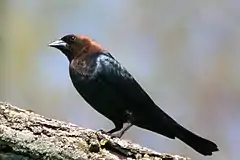| Cowbird | |
|---|---|
.jpg.webp) | |
| Female brown-headed cowbird | |
| Scientific classification | |
| Domain: | Eukaryota |
| Kingdom: | Animalia |
| Phylum: | Chordata |
| Class: | Aves |
| Order: | Passeriformes |
| Family: | Icteridae |
| Genus: | Molothrus Swainson, 1832 |
| Type species | |
| Fringilla pecoris[1] Gmelin, JF, 1789 | |
| Species | |
Cowbirds are birds belonging to the genus Molothrus in the family Icteridae. They are of New World origin, and are obligate brood parasites, laying their eggs in the nests of other species.
The genus was introduced by English naturalist William Swainson in 1832 with the brown-headed cowbird (Molothrus ater) as the type species.[2][3] The genus name combines the Ancient Greek mōlos, meaning "struggle" or "battle", with thrōskō, meaning "to sire" or "to impregnate".[4]
Species
The genus contains six species:[5]
| Image | Scientific name | Common name | Distribution |
|---|---|---|---|
.jpg.webp) | Molothrus rufoaxillaris | Screaming cowbird | Northeast and central Argentina, southeast Bolivia, central Brazil and throughout Paraguay and Uruguay |
.jpg.webp) | Molothrus oryzivorus (formerly in Scaphidura) | Giant cowbird | Southern Mexico south to northern Argentina, and on Trinidad and Tobago |
_male.JPG.webp) | Molothrus bonariensis | Shiny cowbird | South America, the Caribbean, and Florida |
_(7223072934).jpg.webp) | Molothrus aeneus | Bronzed cowbird | Southern U.S. states of California, Arizona, New Mexico, Texas, and Louisiana south through Central America to Panama |
| Molothrus armenti | Bronze-brown cowbird | Colombia | |
 | Molothrus ater | Brown-headed cowbird | Southern Canada, United States, and Mexico |
One extinct species, the Talara cowbird (Molothrus resinosus), is known from fossil remains recovered from the Talara Tar Seeps of northwestern Peru, and likely went extinct during the late Quaternary. It may have been a close associate of Pleistocene megafauna communities, and may have gone extinct following their collapse in populations.[6]
The nonparasitic baywings were formerly placed in this genus; they are now classified as Agelaioides.
Behavior
Cowbirds are insectivores.
The birds in this genus are infamous for laying their eggs in other birds' nests. The female cowbird notes when a potential host bird lays its eggs, and when the nest is left momentarily unattended, the cowbird lays its own egg in it. The female cowbird may continue to observe this nest after laying eggs. Some bird species have evolved the ability to detect such parasitic eggs, and may reject them by pushing them out of their nests, but the female cowbird has been observed to attack and destroy the remaining eggs of such birds as a consequence, dissuading further removals. Widespread predatory behaviors in cowbirds could slow the evolution of rejection behaviors and further threaten populations of some of the greater than 100 species of regular cowbird hosts, favoring host acceptance of parasitic eggs in a mafia-like contest between cowbirds and other species.[7]
References
- ↑ "Icteridae". aviansystematics.org. The Trust for Avian Systematics. Retrieved 2023-07-16.
- ↑ Swainson, William John; Richardson, J. (1831). Fauna boreali-americana, or, The zoology of the northern parts of British America. Vol. Part 2. The Birds. London: J. Murray. p. 277. The title page bears the year 1831 but the volume did not appear until 1832.
- ↑ Paynter, Raymond A. Jr, ed. (1968). Check-list of Birds of the World. Vol. 14. Cambridge, Massachusetts: Museum of Comparative Zoology. p. 195.
- ↑ Jobling, James A. (2010). The Helm Dictionary of Scientific Bird Names. London: Christopher Helm. p. 258. ISBN 978-1-4081-2501-4.
- ↑ Gill, F.; Donsker, D.; Rasmussen, P. (July 2020). "IOC World Bird List (v 10.2)". Retrieved July 15, 2020.
- ↑ Steadman, David W.; Oswald, Jessica A. (July 2020). "New species of troupial (Icterus) and cowbird (Molothrus) from ice-age Peru". The Wilson Journal of Ornithology. 132 (1): 91–103. doi:10.1676/1559-4491-132.1.91. ISSN 1559-4491. S2CID 220714575.
- ↑ Jeffrey P. Hoover; Scott K. Robinson (13 March 2007). "Retaliatory mafia behavior by a parasitic cowbird favors host acceptance of parasitic eggs". Proceedings of the National Academy of Sciences. Retrieved 26 August 2009.
- Jaramillo and Burke, New World Blackbirds ISBN 0-7136-4333-1